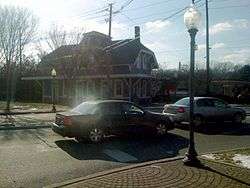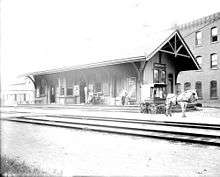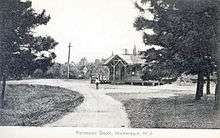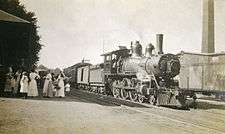New Jersey and New York Railroad
 The Hillsdale station house (1872) was the company headquarters[1] (photo taken 12 January 2010) | |
| Locale | Bergen County, New Jersey & Rockland County, New York |
|---|---|
| Dates of operation | –1896 |
| Predecessor | Hackensack and New York Extension Railroad |
| Successor | Erie Railroad |
| Track gauge | 4 ft 8 1⁄2 in (1,435 mm) standard gauge |
| Headquarters | Hillsdale, New Jersey |
Legend
| ||||||||||||||||||||||||||||||||||||||||||||||||||||||||||||||||||||||||||||||||||||||||||||||||||||||||||||||||||||||||||||||||||||||||||||||||||||||||||||||||||||||||||||||||||||||||||||||||||||||||||||||||||||||||||||||||||||||||||||||||||||||||||
The New Jersey and New York Railroad (NJ&NY) was a railroad company that operated north from Rutherford, New Jersey, to Haverstraw, New York beginning in the mid-to-late 19th century.[3][4] The line was originally chartered as the Hackensack and New York Railroad (H&NY) in 1856. The H&NY would eventually run from Rutherford to Hackensack, New Jersey. In 1866 under the leadership of David P. Patterson the company was rechartered as the Hackensack and New York Extension Railroad and it extended its line north of Hackensack. It later reorganized as the New Jersey and New York Railroad. The line reached the town of Haverstraw, New York by 1870,[1] the village of West Haverstraw by 1873, and the village of Haverstraw by 1887.[3] The NJ&NY was in turn leased for 99 years by the Erie Railroad in 1896.[2] The NJ&NY continued to exist as an Erie subsidiary until the 1960 merger that created the Erie Lackawanna Railroad. In 1976 the Erie Lackawanna was merged with several other railroads to create Conrail. In 1983, after several years under operation by Conrail, operations of the Pascack Valley Line were transferred to New Jersey Transit Rail Operations.[5] The segments of the two former railroad lines in New York: north of Spring Valley to Haverstraw and north of Nanuet to New City; are no longer in service.
In 1956 NJ&NY reported 4.4 million net ton-miles of revenue freight and 21 million passenger-miles on 39 miles of railroad.
Stations
A typical NJ&NY station in the 1900s or 1910s had a gable or hip roof and often had board and batten siding. The larger and more elaborate station at Hillsdale served as the company headquarters and was built in a mixture of the Second Empire and Stick-Eastlake architectural styles. Early photographs of stations along the NJ&NY line include:
 Essex Street station in a 1907 postcard
Essex Street station in a 1907 postcard Anderson Street station in 1910
Anderson Street station in 1910 "Fairmount Depot" in a 1911 postcard
"Fairmount Depot" in a 1911 postcard Pearl River station in 1910
Pearl River station in 1910
References
- 1 2 Mrnarevic, Karen F. (10 December 2009). "Hillsdale's history 'tied' to the railroad". Pascack Valley Community Life. NorthJersey.com. Retrieved 2010-11-09.
- 1 2 3 4 Jones, Wilson E. (1996). The Pascack Valley Line - A History of the New Jersey and New York Railroad. East Hanover, New Jersey: Railroadians of America. ISBN 0-941652-14-9.
- 1 2 "Town of Haverstraw: History". Retrieved 2014-10-02.
- ↑ Please see the 1891 maps of West Haverstraw and Haverstraw village at: Bayley, Don. "Haverstraw Brickmaking". Retrieved 2010-11-08.
- ↑ Havilland, Pierce. "The Pascack Valley Line". Retrieved 2010-11-08.
External links
- A system map at: "Historical Information: Railroad of New Jersey". Retrieved 2010-11-08.